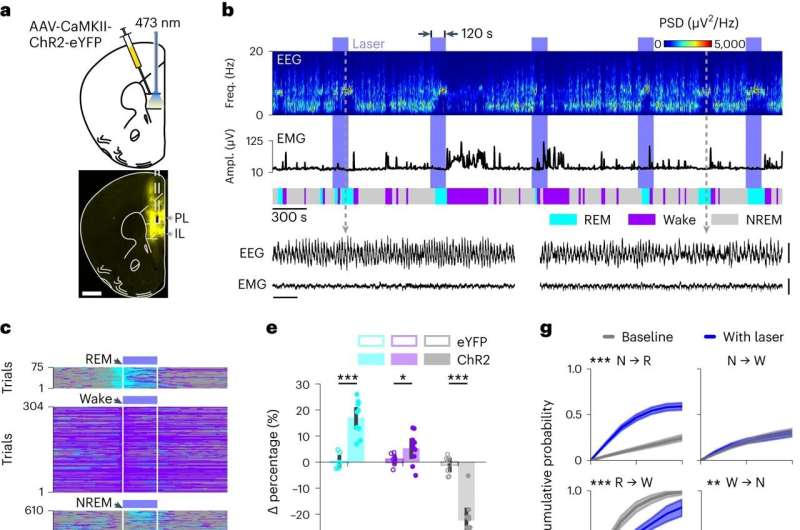October 17, 2023 feature
This article has been reviewed according to Science X's editorial process and policies. Editors have highlighted the following attributes while ensuring the content's credibility:
fact-checked
peer-reviewed publication
trusted source
proofread
Study highlights the key role of the prefrontal cortex in regulating REM sleep

Rapid eye movement (REM) sleep is the stage of the sleep cycle during which vivid dreaming typically takes place. This crucial sleep phase, characterized by relaxed muscles, rapid eye movements, an elevated heart rate and irregular breathing patterns, has been linked to the consolidation of memories and processing of emotions.
Researchers at University of Pennsylvania recently carried out a study exploring the role of the prefrontal cortex (PFC), the anterior part of the brain's outer layer, in regulating REM sleep. The PFC contains different essential brain regions that regulate thinking, actions, emotions, complex planning, memory processes, learning and other vital functions.
"Human imaging studies showed that the medial prefrontal cortex in humans is strongly activated during REM sleep," Franz Weber, one of the researchers who carried out the study, told Medical Xpress. "We wondered whether this activation is just a consequence of subcortical circuits controlling REM sleep or whether the activity of the mPFC itself plays a role in regulating of REM sleep."
As part of their recent study, featured in Nature Neuroscience, Weber and his colleagues set out to determine whether cortical neurons contribute to triggering REM sleep. To do this, they conducted two different experiments on sleeping mice.
In the first experiment, the researchers used targeted techniques to express light-gated ion channels (i.e., channelrhodopsin) in mPFC neurons. This allowed them to determine what happens when these neurons are activated for brief periods of time, particularly in terms of the mice's sleep.
"We found that nearly every time we shined light onto the mPFC to activate neurons during NREM sleep the mouse transitioned to REM sleep," Weber explained. "A second important experiment was monitoring the activity of mPFC neurons. We used calcium imaging by expressing a fluorescent calcium indicator in mPFC neurons. Using this technique, we could then image the activity of mPFC neurons during sleep."
The experimental technique used by Weber and his colleagues images the activity of neurons based on their calcium concentration. When neurons are activated, their calcium concentration rises, which in turn boosts the fluorescence of the calcium indicator they used.
In other words, the more active neurons are, the brighter they will look. The researchers' observations confirmed the role of PFC neurons in REM sleep, as a large number of these neurons were strongly activated as the mice entered this sleep stage.
"One key finding of our study is that the cortex does play a role in the regulation of REM sleep," Weber said. "Most prevalent models of REM sleep control assumed that this brain state is primarily regulated by subcortical neurons in hypothalamus and brainstem. Second, we found that the activity of the mPFC during REM sleep also regulates phasic REM sleep, a substage of REM sleep characterized by rapid eye movements (the reason for the name 'rapid eye movement' sleep)."
The recent findings gathered by Weber and his team delineate a neural circuit involving the cortex and hypothalamus that appears to regulate REM sleep. As dysregulation in the activity of PFC neurons and sleep disturbances have been linked to psychiatric disorders, their findings could also have clinical implications.
For instance, past studies have found that the ventromedial prefrontal cortex, which takes on the same role as the mouse mPFC in the human brain, is hyper-activated in people diagnosed with depression. As the team found that greater mPFC neuron activity increased the number of rapid eye movements while mice sleep, their findings could, among other things, inform the development of techniques to detect and better understand depression utilizing REM sleep patterns.
"We found that activating the mPFC increased the number of rapid eye movements (during REM sleep), while inhibition of the mPFC had the opposite effect," Weber added. "Thus, the overall activity of the mPFC may correlate with the number of rapid eye movements during REM sleep. In other words, observing rapid eye movements may serve as a window into the activity of the prefrontal cortex and may provide information about potential abnormalities in its activity."
More information: Jiso Hong et al, Prefrontal cortical regulation of REM sleep, Nature Neuroscience (2023). DOI: 10.1038/s41593-023-01398-1
© 2023 Science X Network





















